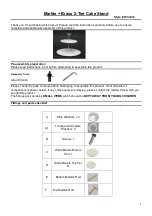
2-4
Rev 2.2, 10/31/94
In speech, the 9th and 10th octaves impart intimacy although too much emphasis can make
secondary speech sounds (lip smacking, etc.) objectionable (a good case for a downward
expander).
Some microphones having a rise at the higher frequencies (especially omni microphones)
benefit from some attenuation in this region. Those microphones having underdamped
diaphragms may ring at these frequencies, causing an annoying sibilant distortion on speech.
On musical forms using hand percussion, boosting this range frequently results in an astonishing
and pleasing feeling of clarity.
2.4.7 Conclusions
When the article containing the above excerpts was written (probably around 1963), stereo was
just becoming a commercial reality (you could still purchase mono and stereo versions of an LP
and there were still more FM stations broadcasting in mono than stereo), and as many mixers
contained rotary mix pots as those that used slide pots. The value of individual channel
equalization was known, but it was both technologically and financially prohibitive. The article
concludes thusly:
"With the advent of stereo and three-channel recording, nearly three times the
equipment, with more elaboration, seems indicated, and expansion of console area in
the horizontal plane offers the only direction in which to proceed. But a single engineer
has arms only so long."
How times have changed!
2.4.8 Equalizing for Speech
In broadcast, equalizers are often used to create a sonic personality for the station's on-air
personalities. In the past, this has often meant using a single non-programmable equalizer in
the announce mic's signal chain. Considering the inverse rule of the knobs (the more knobs
you give them, the easier it is for someone to get hopelessly screwed up!), the attitude of most
station's PDs and engineers was to hide the equalizer somewhere, preferably under lock and
key. The 601makes it easy for each personality to have their own, individualized, curve.
Granted, if you give the jocks access to the unit, someone will inevitably shoot themselves in
the foot, but at least everyone can have their own curve.
Some general thoughts on speech equalization:
1.
Try to use wider bandwidths. Narrower bandwidths (1/2 octave and less) are less audible
(harder to hear) and are generally only useful for remedial work. Broader bandwidths are
less obnoxious, more pleasing sounding, and easier to work with (especially if you're
boosting a range of frequencies).
2.
Try to avoid massive amounts of boost or cut. If you're only trying to impart a flavor (like
sprinkling salt and pepper on a meal), then 6-8 dB of boost or cut should be all that you
need.
3.
A wide bandwidth cut is equivalent to a boost at the frequencies surrounding the cut.
4.
A quick way to figure out what's going on is to set the level of one band of the equalizer to
full boost (+18 dB), then switch to the frequency control and vary the frequency of that
band of the equalizer while listening to program material fed through the unit. This
usually makes quick work out of finding the region that you want to work on. Now reduce
the level setting to something tasteful.
To tailor your station's announce sound, begin with a general idea of the sound (voice
coloration) you want. Since you only have three general locations that you can equalize at,
you'll need to begin with the aspects of your sound that are most important.
Microphone choice is very important, since every microphone imparts its own equalization to
any sound that it hears. If you want a large, "ballsy" sound, you ought to think about single-D
microphones such as those made by AKG, Shure, Neumann, Sennheiser, and EV (like the
Summary of Contents for 601
Page 46: ...4 18 Rev 2 2 10 31 94 This page is blank believe it or not ...
Page 48: ...4 20 Rev 2 2 10 31 94 Notes ...
Page 50: ...5 2 Rev 2 2 10 31 94 Notes ...
Page 70: ...7 16 Rev 2 2 10 31 94 Notes ...
Page 72: ...8 2 Rev 2 2 10 31 94 Notes ...
Page 74: ...9 2 Rev 2 2 10 31 94 Notes ...
Page 78: ...11 2 Rev 2 2 10 31 94 Notes ...
Page 126: ...D 12 Rev 2 2 10 31 94 Notes ...
Page 138: ...G 8 Rev 2 2 10 31 94 Notes ...
















































